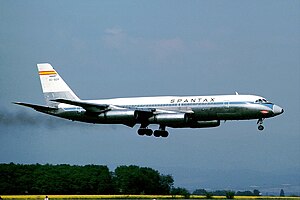Convair 990 Coronado
| Convair 990 Coronado | |
|---|---|
 |
|
| Convair CV-990A of Spantax at Basel Airport. Even at landing power the smoky engines are evident. | |
| Role | Narrow-body jet airliner |
| National origin | United States |
| Manufacturer | Convair |
| First flight | January 24, 1961 |
| Retired | September, 1987 |
| Primary users |
American Airlines Spantax |
| Produced | 1961-1963 |
| Number built | 37 |
| Developed from | Convair 880 |
The Convair 990 Coronado was an American narrow-body four-engined jet airliner produced by the Convair division of General Dynamics, a stretched version of their earlier Convair 880 produced in response to a request from American Airlines. The 990 was lengthened by 10 ft (3.0 m), which increased the number of passengers from between 88 and 110 in the 880, to between 96 and 121. This was still fewer than the contemporary Boeing 707 (110 to 189) or Douglas DC-8 (105 to 173), although the 990 was 25–35 mph (40–56 km/h) faster than either in cruise.
American Airlines asked Convair to design an aircraft for coast-to-coast flights, able to fly nonstop from New York to Los Angeles against the wind. They wanted a somewhat larger passenger capacity than the 880, which was the smallest of the first-generation U.S. jet airliners. The 990 began flight testing January 24, 1961.
One change from the 880 was the large anti-shock bodies on the upper trailing edge of the wings to increase the critical Mach and reduce transonic drag. The inboard shock bodies, which were larger, were also used for additional fuel tankage. Later during the design period, Convair modified the design to include fuel in the outboard pods as well, but during the initial test flights the extra weight caused the outboard engines to oscillate in certain conditions. The pods were redesigned once more, and shortened by 28 inches (710 mm), causing increased drag. The inner set of pods also served a secondary role as fuel dumps for the fuel tanks, and the outlet pipe is prominent.
The engines were also changed to the uprated General Electric CJ-805-23s, which were unique in that they used a fan stage at the rear of the engines, compared to the fan stage at the front of the engine found on the Pratt & Whitney JT3D that powered the 990's competitors. The engine was a simplified, non afterburning civil version of the J79, used in military fighters. Like the J79, the CJ805 was smoky.
Like the 880, 990s incorporated a dorsal "raceway" added to the top of the fuselage to house the two ADF antennas and one VHF antenna
...
Wikipedia
